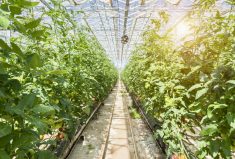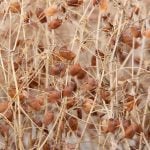Glacier FarmMedia – There are a surprising number of purple foods.
There are purple potatoes, eggplants, grapes, cabbages, carrots, saskatoons and blackberries, though the latter may be more black than purple.
Next year, another food can be added to the list — purple tomatoes.
Read Also

Melancthon faces a new quarry fight over water, environment and farmland risks
A proposed Strada blast quarry in Melancthon, Ont., sparks regional debate over water protection, farmland sustainability, and Ontario’s aggregate policy.
In early September, the U.S. Department of Agriculture (USDA) said a genetically modified tomato, with purple skin and purple flesh, can be grown in America.
The approval comes 14 years after a British scientist devised the purple tomato, which has high levels of antioxidants.
“This is fantastic, I never thought I would see this day. We are now one step closer to my dream of sharing healthy purple tomatoes with the many people excited to eat them,” said Cathie Martin, a plant scientist at the John Innes Centre in Norwich, England.
Why it matters: It took more than 14 years from development to regulatory approval for the purple tomato.
Martin developed the purple tomato in 2008, as part a larger effort to increase beneficial compounds in fruits and vegetables. One of those compounds is anthocyanins, naturally occurring pigments found at high levels in blackberries.
“Anthocyanins offer protection against certain cancers, cardiovascular disease and age-related degenerative diseases. There is evidence that anthocyanins also have anti-inflammatory activity,” the John Innes Centre said in a release from 2008.
Tomato varieties with purple skin do exist, but the levels of anthocyanins are tiny because the antioxidants are only in the skin of the fruit.
Martin came up with the idea of using two genes from a snapdragon, which produce anthocyanins in the purple flower, to do the same thing in tomatoes.
The experiment worked.
The snapdragon genes act like “on” switches, kicking off a biochemical process that produces high levels of the antioxidants in the flesh and skin of the fruit.
Jonathan Jones, a scientist with the Sainsbury Laboratory and Martin’s business partner in a company called Norfolk Plant Sciences, said it took nearly 15 years after the discovery to get a regulatory thumbs up, but their patience paid off.
“This is a red-letter day for crop improvement, with approval of a beneficial product by USDA,” he said. “We also look forward to sensible regulatory frameworks for such products in the U.K., and effective methods to protect our major crops from disease, using genetics instead of chemistry.”
The purple tomato was developed in England, but it hasn’t yet been approved there. That may soon change because Britain is no longer part of the European Union, where genetically modified crops are banned.
The purple tomato is genetically modified but the USDA decided the fruit will not be regulated like a GM food. The U.S. has revised its biotechnology regulations and plant trait developers can ask the USDA for a regulatory status review when they believe the modified plant should not be subject to regulation.
The USDA carried out the review and decided the purple tomato “is unlikely to pose an increased plant pest risk compared to other cultivated tomatoes… That means, from a plant pest risk perspective, this plant may be safely grown and used in breeding in the United States.”
American gardeners should be able to buy seeds and grow the purple tomato in spring 2023.
– This article was originally published at The Western Producer.















